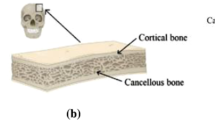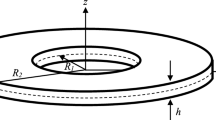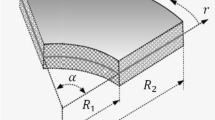Abstract
In this article, a novel numerical approach based on electromechanical coupling isogeometric analysis employing a piecewise linear zig-zag function is proposed for modeling and analysis of smart constrained layer damping (SCLD) treatment in multilayer porous functionally graded graphene platelets-reinforced composite (PFG-GPRC) plates. The approach efficiently approximates the geometric, mechanical, and electric displacement fields by utilizing non-uniform rational B-splines (NURBS) basis functions. These basis functions are subsequently integrated with the zig-zag formulation to characterize the system dynamic and help handle both continuous/discontinuous material properties at all interfaces, as well as improve the effectiveness of global–local numerical solutions for the analysis of current structures. The multilayer PFG-GPRC plate model is designed to incorporate porous, uniformly, or non-uniformly distributed layers based on three different graphene platelet patterns. The analysis of the SCLD treatment encompasses an examination of the frequency response function of the damped structure under passive/hybrid mechanisms, taking into account viscoelastic behavior and the converse piezoelectric effect. Reliability in the current analysis is demonstrated through a validation study, and a comprehensive parametric investigation is undertaken to analyze the impact of various parameters related to graphene platelets (GPLs) and distribution types of porosity on the damping behavior of multilayer PFG-GPRC plates.




















Similar content being viewed by others
References
Thostenson, E.T., Ren, Z., Chou, T.W.: Advances in the science and technology of carbon nanotubes and their composites: a review. Compos. Sci. Technol. 61(13), 1899–1912 (2001)
Mehar, K., Panda, S.K., Sharma, N.: Numerical investigation and experimental verification of thermal frequency of carbon nanotube-reinforced sandwich structure. Eng. Struct. 211, 110444 (2020)
Rafiee, M.A., Rafiee, J., Wang, Z., Song, H., Yu, Z.Z., Koratkar, N.: Enhanced mechanical properties of nanocomposites at low graphene content. ACS Nano 3(12), 3884–3890 (2009)
Balandin, A.A., Ghosh, S., Bao, W., Calizo, I., Teweldebrhan, D., Miao, F., Lau, C.N.: Superior thermal conductivity of single-layer graphene. Nano Lett. 8(3), 902–907 (2008)
Lee, C., Wei, X., Kysar, J.W., Hone, J.: Measurement of the elastic properties and intrinsic strength of monolayer graphene. Science 321(5887), 385–388 (2008)
Du, X., Skachko, I., Barker, A., Andrei, E.Y.: Approaching ballistic transport in suspended graphene. Nat. Nanotechnol. 3(8), 491–495 (2008)
Ramteke, P.M., Mahapatra, B.P., Panda, S.K., Sharma, N.: Static deflection simulation study of 2d functionally graded porous structure. Mater. Today Proc. 33, 5544–5547 (2020)
Ramteke, P.M., Sharma, N., Choudhary, J., Hissaria, P., Panda, S.K.: Multidirectional grading influence on static/dynamic deflection and stress responses of porous FG panel structure: a micromechanical approach. Eng. Comput. 38(Suppl 4), 3077–3097 (2022)
Yang, J., Wu, H., Kitipornchai, S.: Buckling and postbuckling of functionally graded multilayer graphene platelet-reinforced composite beams. Compos. Struct. 161, 111–118 (2017)
Song, M., Kitipornchai, S., Yang, J.: Free and forced vibrations of functionally graded polymer composite plates reinforced with graphene nanoplatelets. Compos. Struct. 159, 579–588 (2017)
Feng, C., Kitipornchai, S., Yang, J.: Nonlinear bending of polymer nanocomposite beams reinforced with non-uniformly distributed graphene platelets (GPLS). Compos. B Eng. 110, 132–140 (2017)
Song, M., Yang, J., Kitipornchai, S.: Bending and buckling analyses of functionally graded polymer composite plates reinforced with graphene nanoplatelets. Compos. B Eng. 134, 106–113 (2018)
Thai, C.H., Ferreira, A., Tran, T., Phung-Van, P.: Free vibration, buckling and bending analyses of multilayer functionally graded graphene nanoplatelets reinforced composite plates using the nurbs formulation. Compos. Struct. 220, 749–759 (2019)
Wang, Y., Xie, K., Fu, T., Shi, C.: Vibration response of a functionally graded graphene nanoplatelet reinforced composite beam under two successive moving masses. Compos. Struct. 209, 928–939 (2019)
Nematollahi, M.S., Mohammadi, H., Dimitri, R., Tornabene, F.: Nonlinear vibration of functionally graded graphene nanoplatelets polymer nanocomposite sandwich beams. Appl. Sci. 10(16), 5669 (2020)
Yang, Z., Zhao, S., Yang, J., Lv, J., Liu, A., Fu, J.: In-plane and out-of-plane free vibrations of functionally graded composite arches with graphene reinforcements. Mech. Adv. Mater. Struct. 28(19), 2046–2056 (2021)
Preumont, A., Seto, K.: Active Control of Structures. Wiley, New York (2008)
Zhang, J., He, L., Wang, E., Gao, R.: Active vibration control of flexible structures using piezoelectric materials. In: 2009 International Conference on Advanced Computer Control, pp. 540–545. IEEE (2009)
Selim, B., Liu, Z., Liew, K.: Active vibration control of functionally graded graphene nanoplatelets reinforced composite plates integrated with piezoelectric layers. Thin-Walled Struct. 145, 106372 (2019)
Nguyen, N.V., Lee, J., Nguyen-Xuan, H.: Active vibration control of GPLS-reinforced FG metal foam plates with piezoelectric sensor and actuator layers. Compos. B Eng. 172, 769–784 (2019)
Nguyen, L.B., Nguyen, N.V., Thai, C.H., Ferreira, A., Nguyen-Xuan, H.: An isogeometric bézier finite element analysis for piezoelectric FG porous plates reinforced by graphene platelets. Compos. Struct. 214, 227–245 (2019)
Dong, Y., Li, Y., Li, X., Yang, J.: Active control of dynamic behaviors of graded graphene reinforced cylindrical shells with piezoelectric actuator/sensor layers. Appl. Math. Model. 82, 252–270 (2020)
Nguyen, N.V., Lee, J.: On the static and dynamic responses of smart piezoelectric functionally graded graphene platelet-reinforced microplates. Int. J. Mech. Sci. 197, 106310 (2021)
Singh, V.K., Mahapatra, T.R., Panda, S.K.: Nonlinear transient analysis of smart laminated composite plate integrated with PVDF sensor and AFC actuator. Compos. Struct. 157, 121–130 (2016)
Singh, V.K., Mahapatra, T.R., Panda, S.K.: Nonlinear flexural analysis of single/doubly curved smart composite shell panels integrated with PFRC actuator. Eur. J. Mech A Solids 60, 300–314 (2016)
Baz, A.M.: Active and Passive Vibration Damping. Wiley, New York (2019)
Ray, M., Pradhan, A.: The performance of vertically reinforced 1–3 piezoelectric composites in active damping of smart structures. Smart Mater. Struct. 15(2), 631 (2006)
Ray, M., Reddy, J.: Active damping of laminated cylindrical shells conveying fluid using 1–3 piezoelectric composites. Compos. Struct. 98, 261–271 (2013)
Kattimani, S., Ray, M.: Smart damping of geometrically nonlinear vibrations of magneto-electro-elastic plates. Compos. Struct. 114, 51–63 (2014)
Kumar, A., Ray, M.: Control of smart rotating laminated composite truncated conical shell using ACLD treatment. Int. J. Mech. Sci. 89, 123–141 (2014)
Datta, P., Ray, M.: Three-dimensional fractional derivative model of smart constrained layer damping treatment for composite plates. Compos. Struct. 156, 291–306 (2016)
Nguyen-Thoi, T., Ly, K.D., Truong, T.T., Nguyen, S.N., Mahesh, V.: Analysis and optimal control of smart damping for porous functionally graded magneto-electro-elastic plate using smoothed fem and metaheuristic algorithm. Eng. Struct. 259, 114062 (2022)
Ramteke, P.M.: Effect of grading pattern and porosity on the eigen characteristics of porous functionally graded structure. Steel Compos. Struct. Int. J. 33(6), 865–875 (2019)
Ramteke, P.M., Panda, S.K.: Free vibrational behaviour of multi-directional porous functionally graded structures. Arab. J. Sci. Eng. 46, 7741–7756 (2021)
Ramteke, P.M., Panda, S.K.: Computational modelling and experimental challenges of linear and nonlinear analysis of porous graded structure: a comprehensive review. Arch. Comput. Methods Eng. 30(5), 3437–3452 (2023)
Sharma, A., Kumar, A., Susheel, C., Kumar, R.: Smart damping of functionally graded nanotube reinforced composite rectangular plates. Compos. Struct. 155, 29–44 (2016)
Sahoo, S., Ray, M.: Analysis of smart damping of laminated composite beams using mesh free method. Int. J. Mech. Mater. Des. 14(3), 359–374 (2018)
Liu, G.R., Trung, N.: Smoothed Finite Element Methods. CRC Press, Boco Raton (2016)
Nguyen-Thoi, T., Phung-Van, P., Nguyen-Xuan, H., Thai-Hoang, C.: A cell-based smoothed discrete shear gap method using triangular elements for static and free vibration analyses of reissner-mindlin plates. Int. J. Numer. Methods Eng. 91(7), 705–741 (2012)
Nguyen-Thoi, T., Phung-Van, P., Thai-Hoang, C., Nguyen-Xuan, H.: A cell-based smoothed discrete shear gap method (CS-DSG3) using triangular elements for static and free vibration analyses of shell structures. Int. J. Mech. Sci. 74, 32–45 (2013)
Nguyen, S.N., Truong, T.T., Cho, M., Trung, N.T.: A cell-based smoothed finite element formulation for viscoelastic laminated composite plates considering hygrothermal effects. J. Compos. Mater. 55(14), 1967–1978 (2021)
Ly, D.K., Truong, T.T., Nguyen, S.N., Nguyen-Thoi, T.: A smoothed finite element formulation using zig-zag theory for hybrid damping vibration control of laminated functionally graded carbon nanotube reinforced composite plates. Eng. Anal. Bound. Elem. 144, 456–474 (2022)
Guo, H., Zhuang, X., Rabczuk, T.: A deep collocation method for the bending analysis of kirchhoff plate (2021). arXiv preprint arXiv:2102.02617
Samaniego, E., Anitescu, C., Goswami, S., Nguyen-Thanh, V.M., Guo, H., Hamdia, K., Zhuang, X., Rabczuk, T.: An energy approach to the solution of partial differential equations in computational mechanics via machine learning: concepts, implementation and applications. Comput. Methods Appl. Mech. Eng. 362, 112790 (2020)
Hughes, T.J., Cottrell, J.A., Bazilevs, Y.: Isogeometric analysis: Cad, finite elements, nurbs, exact geometry and mesh refinement. Comput. Methods Appl. Mech. Eng. 194(39–41), 4135–4195 (2005)
Fernández Casanova, C., et al.: Analysis of Composite Shells: Isogeometric Modelling and Damage identification. Universidad de Granada (2014)
Singh, S., Singh, I.V.: Extended isogeometric analysis for fracture in functionally graded magneto-electro-elastic material. Eng. Fract. Mech. 247, 107640 (2021)
Nguyen, T.N., Thai, C.H., Luu, A.T., Nguyen-Xuan, H., Lee, J.: Nurbs-based postbuckling analysis of functionally graded carbon nanotube-reinforced composite shells. Comput. Methods Appl. Mech. Eng. 347, 983–1003 (2019)
Phung-Van, P., Nguyen, L.B., Tran, L.V., Dinh, T.D., Thai, C.H., Bordas, S., Abdel-Wahab, M., Nguyen-Xuan, H.: An efficient computational approach for control of nonlinear transient responses of smart piezoelectric composite plates. Int. J. Non-Linear Mech. 76, 190–202 (2015)
Phung-Van, P., Tran, L.V., Ferreira, A., Nguyen-Xuan, H., Abdel-Wahab, M.: Nonlinear transient isogeometric analysis of smart piezoelectric functionally graded material plates based on generalized shear deformation theory under thermo-electro-mechanical loads. Nonlinear Dyn. 87(2), 879–894 (2017)
Shafei, E., Faroughi, S., Rabczuk, T.: Nonlinear transient vibration of viscoelastic plates: a nurbs-based isogeometric hsdt approach. Comput. Math. Appl. 84, 1–15 (2021)
Reddy, J.N.: Mechanics of Laminated Composite Plates and Shells: Theory and Analysis. CRC Press, Boco Raton (2003)
Liew, K., Pan, Z., Zhang, L.: An overview of Layerwise theories for composite laminates and structures: development, numerical implementation and application. Compos. Struct. 216, 240–259 (2019)
Murakami, H.: Laminated composite plate theory with improved in-plane responses. J. Appl. Mech. 53(3), 661–666 (1986)
Carrera, E.: On the use of the Murakami’s zig-zag function in the modeling of layered plates and shells. Comput. Struct. 82(7–8), 541–554 (2004)
Tessler, A., DiSciuva, M., Gherlone, M.: Refined zigzag theory for laminated composite and sandwich plates (2009)
Nguyen, S.N., Lee, J., Cho, M.: A triangular finite element using laplace transform for viscoelastic laminated composite plates based on efficient higher-order zigzag theory. Compos. Struct. 155, 223–244 (2016)
Nguyen, S.N., Lee, J., Cho, M.: Viscoelastic behavior of naghdi shell model based on efficient higher-order zig-zag theory. Compos. Struct. 164, 304–315 (2017)
Yang, J., Chen, D., Kitipornchai, S.: Buckling and free vibration analyses of functionally graded graphene reinforced porous nanocomposite plates based on Chebyshev–Ritz method. Compos. Struct. 193, 281–294 (2018)
Nguyen, V.P., Anitescu, C., Bordas, S.P., Rabczuk, T.: Isogeometric analysis: an overview and computer implementation aspects. Math. Comput. Simul. 117, 89–116 (2015)
Lim, Y.H., Varadan, V.V., Varadan, V.K.: Closed loop finite-element modeling of active constrained layer damping in the time domain analysis. Smart Mater. Struct. 11(1), 89 (2002)
Li, K., Wu, D., Chen, X., Cheng, J., Liu, Z., Gao, W., Liu, M.: Isogeometric analysis of functionally graded porous plates reinforced by graphene platelets. Compos. Struct. 204, 114–130 (2018)
Acknowledgements
This study was supported by Bualuang ASEAN Chair Professor Fund.
Funding
Bualuang ASEAN Chair Professor Fund (Bualuang ASEAN Chair Professor).
Author information
Authors and Affiliations
Corresponding author
Ethics declarations
Data availability
No data were used for the research described in the article.
Conflict of interest
The authors declare that they have no known competing financial interests or personal relationships that could have appeared to influence the work reported in this paper.
Additional information
Publisher's Note
Springer Nature remains neutral with regard to jurisdictional claims in published maps and institutional affiliations.
Appendix
Appendix
1.1 Stiffness and rigidity matrices related to the PFG-GPRC/ACLD plate
The matrices appearing in Eqs. (39)–(40) are given by
The elemental elastic stiffness matrices:
in which
in which
in which
in which
Rights and permissions
Springer Nature or its licensor (e.g. a society or other partner) holds exclusive rights to this article under a publishing agreement with the author(s) or other rightsholder(s); author self-archiving of the accepted manuscript version of this article is solely governed by the terms of such publishing agreement and applicable law.
About this article
Cite this article
Nguyen-Thoi, T., Ly, DK., Kattimani, S. et al. An electromechanical coupling isogeometric approach using zig-zag function for modeling and smart damping control of multilayer PFG-GPRC plates. Acta Mech 235, 941–970 (2024). https://doi.org/10.1007/s00707-023-03785-y
Received:
Revised:
Accepted:
Published:
Issue Date:
DOI: https://doi.org/10.1007/s00707-023-03785-y




